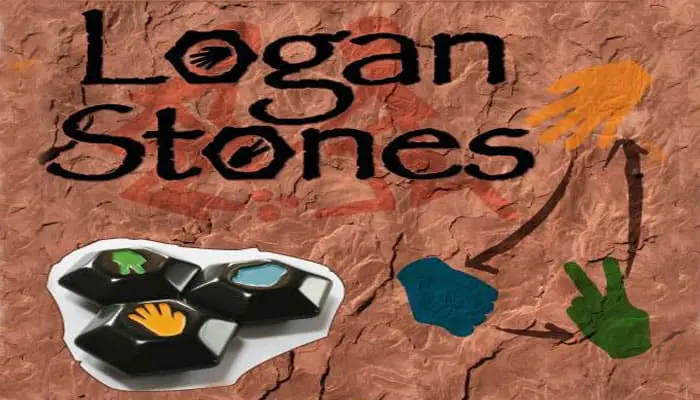
Logan Stones is a two-player strategic game that encourages memory and tactical thinking. It is played without a board, using 18 tactile pieces that are etched and painted on both sides with different symbols.
The game has simple rules that are based on the visually recognizable symbols of Rock Paper Scissors.

Components
- 18 Tactile Game Pieces
- 6 'Rock' symbols
- 6 'Paper' symbols
- 6 'Scissors' symbols
- Soft Travel Bag
- Illustrated Rules Leaflet
Object of the Game
The object of the game is to make a row of four or more of the same symbol.
The stones that form the island (not the stones that the players have in their hands) do not belong to any one player, so if one player makes a row of three of the same symbol and the next player then adds another stone with the same symbol, they win.

Setup
Start by putting all 18 stones into the bag provided and mix.
Each player should then take eight stones randomly from the bag placing them on the table in front of them, so that the symbols on one face of the stones can be clearly seen by the other player throughout the game.
Take out the remaining two stones from the bag in such a way that the symbols of only one face of the stones are revealed to both players. Then place them in the middle of the table in between the two players. The stones should be placed so that they are touching one another.
 Now you are ready to play the game.
Now you are ready to play the game.
Choosing a starting player and taking consecutive turns, players add one stone at a time from their hand to the playing area, thus building an island of stones as they play.
Adding Stones
When adding a stone to the island, it must be added where it is in contact with at least two other stones.

Flipping Stones

If the symbol on the added stone is of greater value than one or more of the stones it was added next to, then all the lesser value stones that it is in contact with, are flipped over to reveal the symbol on their opposite faces.
Note: The added stone is never flipped, even if it was added next to a stone with a symbol of greater value than its own.
Symbol Value

What happens when all the stones are used up in the players hands?
Once a player has no stones left in their hand, they continue by moving a stone to another position or by choosing to flip a stone in its current position.
Players must first disclose what they intend to do (move or flip) before they maneuver the stone.
Moving a Stone
If choosing to move a stone, it may be put down on either one of its two faces, but may not be put back in the same space it came from.
The rule of Adding Stones continues to apply, wherein; you may only add a stone to a position where it is in contact with at least two other stones. For further restrictions on moving, see also one island rule.

Flip a Stone
If simply flipping a stone, it may be flipped even if it is only in contact with one other stone.
In both cases the Flipping stones rule continues to apply wherein.
Once the stone is moved or flipped, if the symbol on the moved or flipped stone is now of greater value than one or more of the stones it was flipped or moved next to, then all the lesser value stones that it is in contact with, are flipped over to reveal the symbol on their opposite faces.
One Island Rule
You may not move a stone if this would create more than one island. If a stone is the only link between two or more parts of the island, it may not be moved, but it may be flipped.

Why "logan Stones"
Logan Stones (also known as Rocking Stones) are large stones found in nature, that are so finely balanced that the application of just a small force causes them to rock. They are found throughout the world.
We have designed the stones in this game so that they also rock, and therefore are easier to remove and flip without too much disruption to the stones around them.

The best way to remove a stone from its position, is to push down with your thumb on one edge of the top of the stone, and as the stone rocks, lift it out using your forefinger.
Continue Reading
